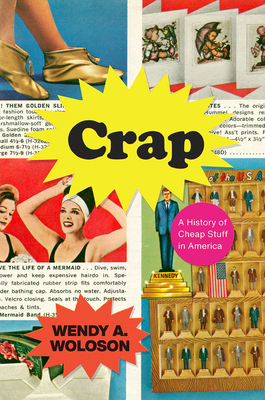
Crap: A History of Cheap Stuff in America
by Wendy A. Woloson
Genres: History, Non-fictionPages: 416
Rating:

Synopsis:Crap. We all have it. Filling drawers. Overflowing bins and baskets. Proudly displayed or stuffed in boxes in basements and garages. Big and small. Metal, fabric, and a whole lot of plastic. So much crap. Abundant cheap stuff is about as American as it gets. And it turns out these seemingly unimportant consumer goods offer unique insights into ourselves--our values and our desires.
In Crap: A History of Cheap Stuff in America, Wendy A. Woloson takes seriously the history of objects that are often cynically-made and easy to dismiss: things not made to last; things we don't really need; things we often don't even really want. Woloson does not mock these ordinary, everyday possessions but seeks to understand them as a way to understand aspects of ourselves, socially, culturally, and economically: Why do we--as individuals and as a culture--possess these things? Where do they come from? Why do we want them? And what is the true cost of owning them?
Woloson tells the history of crap from the late eighteenth century up through today, exploring its many categories: gadgets, knickknacks, novelty goods, mass-produced collectibles, giftware, variety store merchandise. As Woloson shows, not all crap is crappy in the same way--bric-a-brac is crappy in a different way from, say, advertising giveaways, which are differently crappy from commemorative plates. Taking on the full brilliant and depressing array of crappy material goods, the book explores the overlooked corners of the American market and mindset, revealing the complexity of our relationship with commodity culture over time.
By studying crap rather than finely made material objects, Woloson shows us a new way to truly understand ourselves, our national character, and our collective psyche. For all its problems, and despite its disposability, our crap is us.
I’m a little torn on how to rate Wendy A. Woloson’s Crap: A History of Cheap Stuff in America. It’s very thorough, and well-sourced, with 50 pages of numbered end notes, an index, and lots of illustrative images (mostly black-and-white, with a small section of colour plates). The topic is interesting, and somewhat applicable to what I see in the UK too, but it’s lacking a little enthusiasm: I don’t need it to be any kind of memoir, but this feels a touch on the dry academic side.
It’s also a bit repetitive. The chapters/sections are themed, e.g. one on useless gadgetry (though it includes electric toothbrushes, now recommended heavily by dentists, in the category of useless gadgetry? Not entirely sure why, it was a throwaway comment but one which puzzled me), one on free gifts, etc… But that means some comments about the Depression’s affect on the accrual of “crap” feel a bit repetitive, as the trends are usually very similar.
Overall, I think my conclusion is that this was interesting to reflect on, and definitely well presented and sourced, but a bit dry and slow for casual reading, so more for someone who’s interested in quite a serious take on the topic.
Rating: 3/5 (“liked it”)

So, a book I could shelve alongside “Enchanting a Disenchanted World” and “The Communist Manifesto”? I actually probably *would* prefer an academic text on this trend rather than something enthusiastic about tat, so I should throw this on my TBR.
HarpGriffin recently posted…Review: Hidden Places by Claudia Martin
Mostly it was the repetition that annoyed me — like, we get it… I don’t mind academic that much, as you know, but it sort of all compounded.